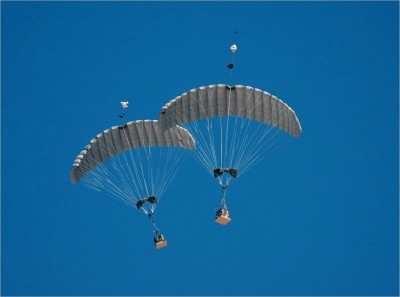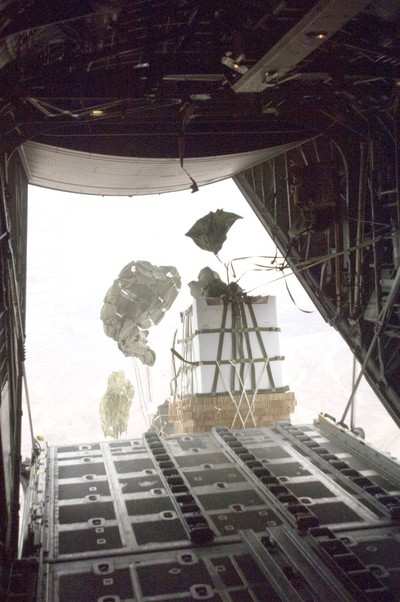Air Force, Army, Contractors Get Supply Drops Back On
Track
Warfighters at forward operating bases have recently begun
receiving supplies via a critical variant of the Joint Precision
Airdrop System again, due to the combined efforts of an Air Force,
Army and contract team. JPADS is a family of equipment consisting
of parachutes, mission-planning systems, global-positioning
systems, and computer hardware and software that allows aircrews to
drop supplies more accurately and from further stand-off
distances.

JPADS Air Drop US Air Force Photo
"JPADS allows aircraft to stay out of the range of many threats,
improving aircrew and aircraft safety, and it also drastically
reduces the need for convoys, reducing the number of troops and
equipment exposed to the threat of (improvised explosive devices),"
said Capt. Michael Kolbe, the JPADS mission planning program
manager at the Electronic Systems Center. "It is a smart system
that uses global positioning, weather modeling and advanced
mathematics to calculate an appropriate drop point and enable a
parachute to fly itself based on the coordinates it receives."
The guided payload 2,200 pound weight class of the JPADS has
been used in theater since 2009 to deliver items such as food,
water, medical supplies and ammunition to military units operating
in areas where it is extremely difficult, and often dangerous, for
vehicles to reach. This is especially important as the amount of
cargo being airdropped to warfighters has significantly increased.
According to U.S. Transportation Command officials, during a
12-week period earlier this year, about 500 bundles, equating to
approximately 450 tons of supplies, were dropped each week in an
area of responsibility.

JPADS Loading US Air Force Photo
Key to JPADS is the accuracy of the drops. In February, after
two 2,200-pound JPADS-guided payloads failed to hit their intended
targets in theater, the joint team decided to put a temporary halt
on operations for this specific JPADS hardware. Other JPADS
ballistic and guided delivery systems did not experience the same
issue and have had continued success in theater. "Warfighters often
operate in austere areas, and the drop zone the cargo needs to land
in may be very small - perhaps only 100 by 100 meters," Captain
Kolbe said. "The 2,200 pound JPADS can deliver to those areas,
while letting us keep our military personnel outside of harm's way.
The team needed to get a correction out to the AOR as soon as
possible."
Officials from both the Air Force and Army, as well as the
original JPADS software creators worked together to find a
solution. "Every time cargo is airdropped, there are a number of
parameters required to define the load attributes. Specific
parachute characteristics, aircraft, payload information, and wind
and weather are just a few," Captain Kolbe said. "What we
discovered is when an airdrop was right on the border of a high
amount of those parameters, it would affect the software, which, in
turn, would affect the launch acceptability region."

US Air Force Photo
Once the LAR was found to be part of the issue, the team worked
toward finding a quick interim resolution. The team upgraded the
current software so when the JPADS mission planner establishes the
LAR, it is augmented with an airborne systems LAR calculator based
on simulation data from actual flights. The user utilizes this
information to accurately plan the mission. With this change, the
team conducted a successful airdrop with two 2,200 pound weight
class payloads in September, and drops are now ongoing in the
AOR.
The JPADS team is currently working to incorporate a long-term
fix with fielding anticipated by February 2011.
 Airbus Racer Helicopter Demonstrator First Flight Part of Clean Sky 2 Initiative
Airbus Racer Helicopter Demonstrator First Flight Part of Clean Sky 2 Initiative Diamond's Electric DA40 Finds Fans at Dübendorf
Diamond's Electric DA40 Finds Fans at Dübendorf ANN's Daily Aero-Term (04.23.24): Line Up And Wait (LUAW)
ANN's Daily Aero-Term (04.23.24): Line Up And Wait (LUAW) NTSB Final Report: Extra Flugzeugbau GMBH EA300/L
NTSB Final Report: Extra Flugzeugbau GMBH EA300/L Classic Aero-TV: 'Never Give Up' - Advice From Two of FedEx's Female Captains
Classic Aero-TV: 'Never Give Up' - Advice From Two of FedEx's Female Captains





